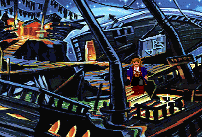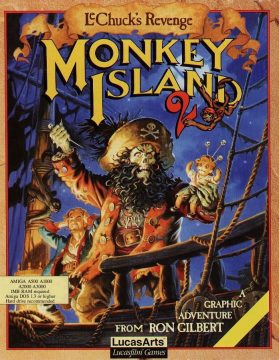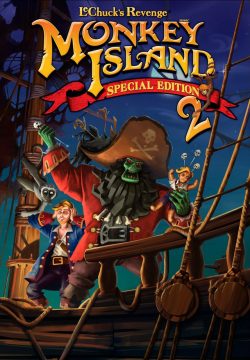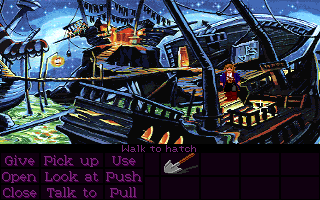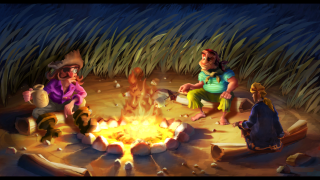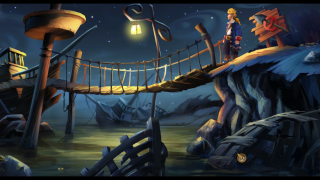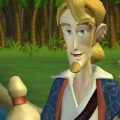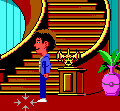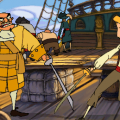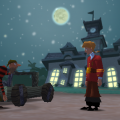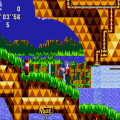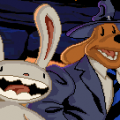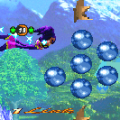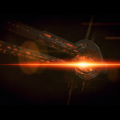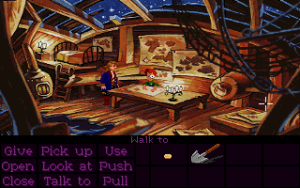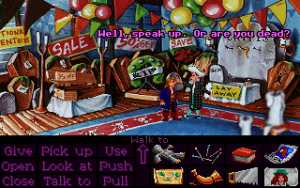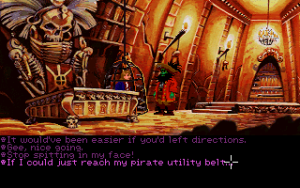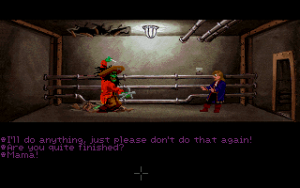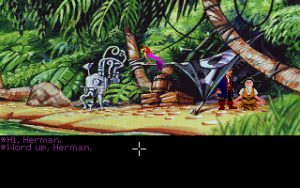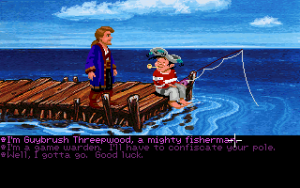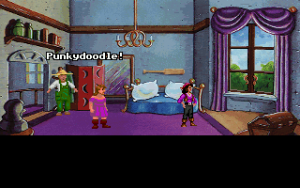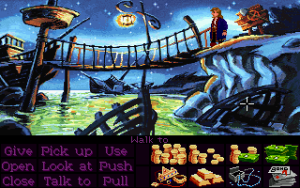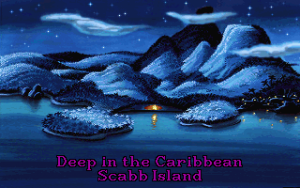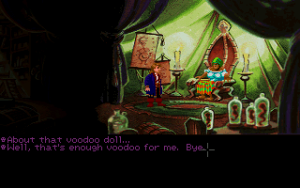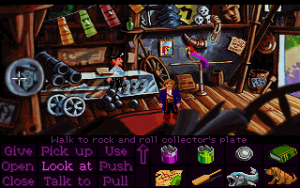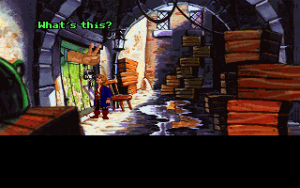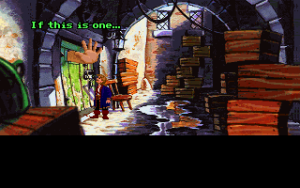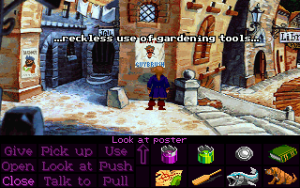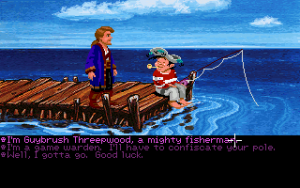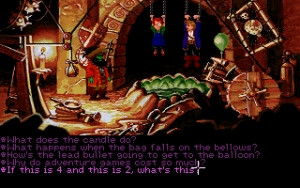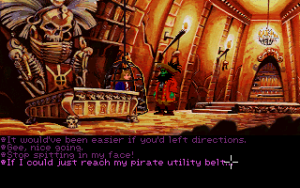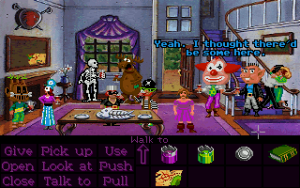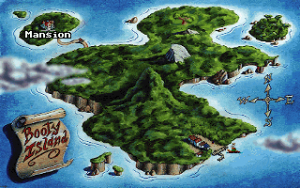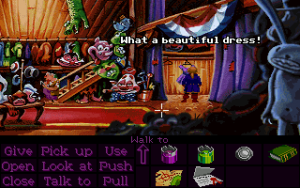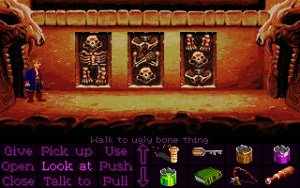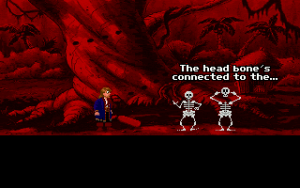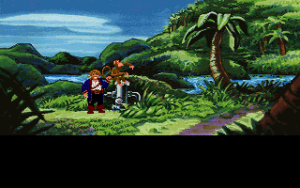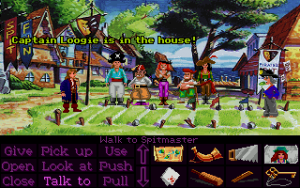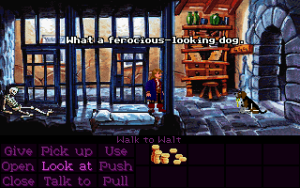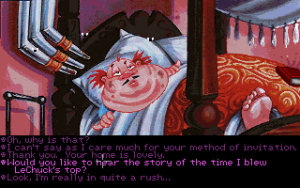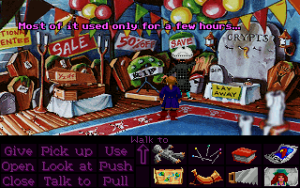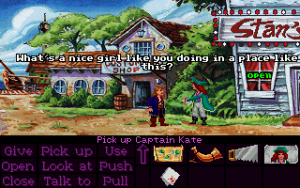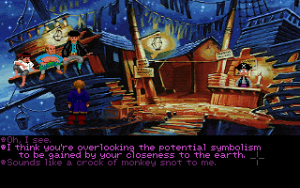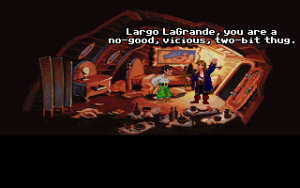- Monkey Island (Introduction)
- Secret of Monkey Island, The
- Monkey Island 2: LeChuck’s Revenge
- Curse of Monkey Island, The
- Escape from Monkey Island
- Tales of Monkey Island
The second Monkey Island game begins with Guybrush literally hanging by a thread, dangling helplessly over a pit and grasping onto some kind of treasure chest. Elaine Marley swoops in to save the day, but not before she makes our hero recount the tale of his precarious position. Jumping back a few days in the past, we join Guybrush telling a story around a campfire. He’s now a full-fledged pirate, complete with blue overcoat and scruffy facial hair, but his glory days are behind him. He continues to recount his tale of LeChuck’s defeat, although the few that actually believe him are sick of his stories, and his romance with Elaine clearly didn’t last, either.
Not content with being a one-hit wonder, Guybrush sets off to make a name for himself by hunting down the legendary treasure Big Whoop. As one can expect, though, he’s not terribly good at his profession, and ends up stranded on Scabb Island. Scabb is ruled by a little bully named Largo LaGrande, who harasses its inhabitants and has instilled an embargo against any ships. The only way to rid the island of this menace is by aiding the Voodoo Lady and constructing a voodoo doll with bits and pieces of Largo’s persona. (Something of the Thread, something of the Head, something of the Body, and something of the Dead.) Upon ridding the island of the little bastard, Guybrush accidentally gives Largo a piece of LeChuck’s beard, allowing him to resurrect the not-quite-so-dead pirate, who now comes back as a zombie.
Undeterred, Guybrush hunts down pieces of the map to Big Whoop by searching the local islands – the festive Booty Island, governed by Elaine Marley herself, and the oppressive Phatt Island, ruled by a bloated pig of a man. This second act is by far the longest, with each of the four map pieces requiring multiple steps to hunt down. The Tri-Island Area is home of numerous puzzles and dozens of items, but upon taking it step by step, you can eventually piece together the route to each of the four map pieces. It’s also cool how the game doesn’t completely forget Scabb Island – you’ll need to revisit it several times, allowing you to interact further with some of the characters from the first chapter.
After piecing everything together (and avoiding any attempts on his life by LeChuck), Guybrush happens upon LeChuck’s Fortress and discovers the terrible secret behind his beloved treasure. The final puzzle is a bit brilliant, as it’s a variation on the task from the first chapter. You need to create a voodoo doll of LeChuck, much as you did with Largo, except since you’re constantly being harassed by the zombie pirate, you need to think of clever ways to distract him and grab the items that you need.
Although it’s not necessarily longer than its predecessor, Monkey Island 2 certainly feels larger, especially since you spend most of the time traveling between three islands, each with several locations of their own. It’s also a much brighter game, too. While Scabb Island, much like Mêlée Island, is perpetually stuck in twilight, the rest of the locations are more colorful and detailed. Much of this is due to the artists drawing the backgrounds by hand then scanning them into the computer, much like Sierra games had started to do around King’s Quest V. Due to the color and resolution limitations, along with inexperience with the digital scanner, they look a bit messy, but the actual artwork is fantastic, and the sprites are just as expressive and animated as its predecessor.
Much of the atmosphere is also conveyed through the amazing soundtrack. The first Monkey Island had some great music, but it was sparse, and huge chunks of the game were played in silence. Monkey Island 2 was the first game that used the iMUSE system, which perfectly transitions the music from screen to screen. Every screen in Woodtick village has a unique melody, each of which exemplifies its inhabitants and the town in general. Many of LucasArts’ subsequent games also used iMUSE, but outside of the X-Wing and TIE Fighter games, none used them as well as Monkey Island 2.
Many familiar faces from the first game return, including the Men of Low Moral Fiber (Pirates), the Voodoo Lady, and good old Stan (who’s now in the business of selling used coffins). There are plenty of new and memorable characters too, like the near-sighted cartographer Wally (whom you rudely steal a monocle from early on), Jojo the piano playing monkey, and the hard-of-hearing laundry clerk Mad Marty.
Of course, Monkey Island 2 is remarkably funny. There are dozens upon dozens of weird, strange and memorable moments throughout the entire adventure. In one, Guybrush knocks himself unconscious and has a dream where his long-lost parents come to visit him, but end up turning into skeletons and singing a variation on the folk song “Dem Bones”. It’s not only weird and trippy, but it foreshadows some of the darker moments of the game, and also provides some hints for a later puzzle. It’s also insanely catchy. Some of it gets a bit silly and lowbrow too, like when Guybrush needs to dig up some remains from a grave. He holds up the bone to the sky, the music turns dramatic, the lighting strikes in the background… then his pants fall down.
The library contains dozens upon dozens of silly titles, including several of Guybrush’s own (reportedly terrible) memoirs. There’s an amusing allusion to the Pirates of the Caribbean ride, where you’re stranded in a cell and need to somehow get the key from the dog that’s sitting just outside of your reach. And many of the laughs revolve around Guybrush’s slightly amoral approach to puzzle solving. Need some cash? Well, simply steal a cowering rat (from the Men with Low Moral Fiber), sneak into the bar’s kitchen, toss the rat in the soup, get the current cook fired, get hired in his stead, take your advance salary, and sneak back out through the window. At one point you need a key from Stan – so, you convince him to hop into a coffin (to demonstrate its roominess), nail it shut, and make off with the key with him trapped inside. In fact, many of the puzzles revolve around distracting people so you can run in and steal something. The game actually keeps a running tally of all of Guybrush’s misdeeds, in the form of a wanted poster on Phatt Island, which shows a picture of Guybrush as he appeared in the first game, but with a mustache doodled on.
By this point, LucasArts realized that some of their puzzles were a bit too bizarre. To compensate, there are two difficulty levels: Normal (“for video game reviewers”, claims the packaging) and Hard. The storyline and events are the same for each, but Hard mode is substantially more elaborate and takes quite a bit more brainwork to solve. It’s not unnaturally difficult, about on the same level as the first game. On the other hand, the Normal mode cuts out so many puzzles that it’s almost stupidly easy. For example, one of the map pieces is in an antique store. In Hard mode, you need to trade for it with an artifact from a sunken galleon, which starts off a whole big chain of events. In Normal mode, you just buy it outright.
Hard mode does have a few annoying puzzles though. At one point you need to find a wrench to use on a pump. There are no tools of the sort, but you can use a hypnotized monkey to do the same thing. It’s pretty funny, except a “monkey wrench” happens to be a uniquely American term, making this puzzle pretty nonsensical to anyone outside the country. At another point, you need to win a spitting contest. First, you need to thicken your saliva by concocting a special drink – not too hard. Then, you need to rearrange the flags on the field to make the goal shorter – again, pretty much in line with the usual puzzles. But, what’s not immediately apparent is that you need to wait for the wind to blow in order for the spit to travel far enough. The only indication that the wind is blowing is the movement of the scarf that one of the audience members is wearing – a detail so small you could assume it was just a regular part of the animation. (The remake adds in sound effects, making the wind more apparent.)
But by far the most controversial aspect is the ending. It’s full of unconventional twists and revelations, as Big Whoop is far from the typical pirate treasure that both Guybrush and the player were probably expecting. As the result, the finale is a bit out there, especially since it ends so suddenly. At least the sting of the finale is lessened by its sequel, but for fans that played it back in the day, the long wait between the second and third games – six years total – proved more than a bit frustrating.
In spite of this, Monkey Island 2 is still a fantastic game, and is remarkably well regarded by its fans. Though its sequels are still excellent, there’s something vaguely kooky – and even foreboding – about the atmosphere that its sequels couldn’t quite capture, and with that, it still remains incredibly unique even amongst its immediate brethren.
Most of the computer versions of Monkey Island 2 are pretty similar, with the only major difference being color depth and music quality. However, in 2010, following the success of The Secret of Monkey Island: Special Edition, LucasArts gave an overhaul to the second game, too. Many of the basic features are the same – upgraded graphics, full voice acting, enhanced music and redone interface – along with the ability to switch back to the original “Classic” mode at any time. It’s definitely clear that much more time, money, and effort were put into this one. The background artwork is simply stunning, perfectly capturing the look and feel of the original scenes while making them much, much crisper. The sprites are much improved too, with Guybrush looking substantially better, as LucasArts responded to the criticisms towards his hair in the first Special Edition. The animations are much more fluid, too. Some of them look pretty awkward, but the quality is still far more hit than miss. The voice acting is still aces, you can skip individual lines of dialogue again, and you can listen to it in classic mode too. The interface has been fixed so you can bring up a context sensitive command menu by clicking on something, which is vaguely similar to the one implemented in The Curse of Monkey Island. You can also directly control Guybrush with a control pad, if you have a strange aversion to mice or are playing the console version.
Still, even though it’s a vast improvement over the first Special Edition, it’s not without some hiccups. All of the music has been redone again, and sounds fantastic, but since it’s all prerecorded with live instruments, it’s extremely difficult to implement the musical transitions from iMUSE. The computer versions do their best and sound almost perfect, except for those with the most trained ears, but the Xbox 360 versions just crossfades the tunes, and it sounds off. The Classic mode also uses some lousy instrumentation, as opposed to the Adlib FM synth most old school PC gamers are probably familiar with, or the far superior Roland MT-32 music.
There’s also a Developer Commentary mode, featuring comments from Ron Gilbert, Tim Schafer and David Grossman. At certain points through the game, you can hit a button and their shadows pop up, Mystery Science Theater 3000-style, and they’ll reminisce about the game’s development. There’s some good stuff, but they seem to ignore the most potentially interesting points, like the crazier puzzles or, more importantly, the ending. It also won’t remember if you’ve listened to a commentary and will prompt you every time you enter the screen, unless you disable the whole feature.
Elements like these feel a bit glitchy and unpolished, but some things have been strangely removed from the upgraded version, too. The opening credit sequence is gone, which shouldn’t sound like a big deal, but it was a funny little bit featuring dancing monkeys. The ending originally displayed several dozen suggestions of what you should be doing instead of being cooped up playing computer games (“paint a stranger’s house in the middle of the night”, or “publish a magazine about pencil shavings” or “sing Welsh folk songs at the bank”) but these were missing in the initial release. They’re available in Classic mode, at least, and they were added post-release via a patch. There’s no Easy mode at all either, as only the Hard mode is available.
